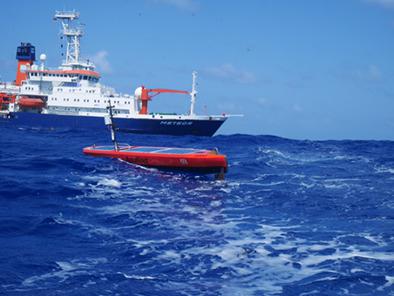Weather ( IF 2.3 ) Pub Date : 2021-05-30 , DOI: 10.1002/wea.4004 Elizabeth Siddle 1 , Karen J. Heywood 1 , Benjamin G. M. Webber 1 , Peter Bromley 2

|
Introduction
In the tropics, air–sea interactions are an important driver of weather and climate variability and can seed extreme weather events. Robust, accurate and widespread observations at the air–sea interface can improve our understanding of air–sea interaction, help to validate coupled climate models and improve the initial conditions for weather forecasts. A crucial component of the air–sea interaction is the exchange of heat and moisture at the surface. When observing these fluxes, satellites and vessels can only take us so far. To make the next step in understanding air–sea interactions, a comprehensive network of flux measurement platforms, able to sample for extended periods of time, is needed (Cronin et al., 2019).
Nowadays, there are a range of instruments spread across global oceans to capture in situ measurements as part of systems like the Global Ocean Observing System (GOOS) and the EUMETNET Surface Marine Programme. Some examples relevant to the collection of observations at the air–sea interface include the Argo network, moored and drifting buoys, and ships. However, these systems have their limitations: vessels are costly and thus only provide sparse coverage, while moorings rely on deployment and maintenance from a ship, another costly procedure. Argo floats have provided a step change in global coverage of ocean observations, but they typically only surface at 10-day intervals and so are unsuited to studying air–sea interactions on short time scales. Drifting buoys also require deployment by vessel and cannot be targeted to a region of interest, and most drifting platforms only measure near-surface ocean temperature and atmospheric pressure, in addition to recording their position. There are efforts to incorporate a range of meteorological and ocean sensors onto drifters (Centurioni et al., 2019) but their Lagrangian nature still limits their use when a set location is to be studied.
The development of autonomous surface vessels allows targeted measurements of a wide suite of surface ocean and atmospheric data in particular regions of interest, over long time periods. These vessels will be a key component of future global in situ arrays of observation platforms for air–sea fluxes with high spatial resolution and minimal reliance on ship time. Ideally, these surface vessels would be non-polluting and powered by renewable resources, such as waves, wind and sun.
中文翻译:

使用新型无人水面船 Caravela 首次测量热带北大西洋的海洋和大气
介绍
在热带地区,海气相互作用是天气和气候变化的重要驱动因素,并可能引发极端天气事件。在海气界面进行稳健、准确和广泛的观测可以提高我们对海气相互作用的理解,有助于验证耦合气候模型并改善天气预报的初始条件。海气相互作用的一个重要组成部分是地表的热量和水分交换。在观察这些通量时,卫星和船只只能带我们走这么远。为了进一步了解海气相互作用,需要一个能够长时间采样的综合通量测量平台网络(Cronin等人, 2019 年)。
如今,作为全球海洋观测系统 (GOOS) 和 EUMETNET 表面海洋计划等系统的一部分,有一系列遍布全球海洋的仪器可以捕获原位测量结果。与在海空界面收集观测资料相关的一些例子包括 Argo 网络、系泊浮标和漂流浮标以及船舶。然而,这些系统有其局限性:船只成本高昂,因此只能提供稀疏的覆盖范围,而系泊系统则依赖于船只的部署和维护,这是另一项昂贵的程序。Argo 浮标为海洋观测的全球覆盖范围提供了阶跃性变化,但它们通常仅每隔 10 天浮出水面一次,因此不适合研究短时间尺度的海气相互作用。漂流浮标也需要通过船只部署,不能针对感兴趣的区域,大多数漂流平台除了记录其位置外,还只能测量近地表海洋温度和大气压力。正在努力将一系列气象和海洋传感器纳入漂流器(Centurioniet al ., 2019 ),但是当要研究固定位置时,它们的拉格朗日性质仍然限制了它们的使用。
自主水面船只的发展使得可以在很长的一段时间内对特定感兴趣区域中广泛的海洋和大气数据进行有针对性的测量。这些船只将成为未来的全球性海空通量观测平台阵列的关键组成部分,这些平台具有高空间分辨率和对船期的最小依赖。理想情况下,这些水面船只将是无污染的,并由波浪,风和太阳等可再生资源提供动力。











































 京公网安备 11010802027423号
京公网安备 11010802027423号